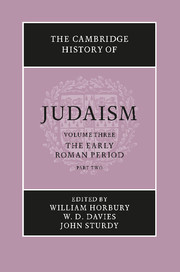Book contents
- Frontmatter
- 1 The archaeology of Palestine 63 bce–ce 70
- 2 The Herodian Temple
- 3 Recent archaeology in Palestine: achievements and future goals
- 4 The contribution of Jewish inscriptions to the study of Judaism
- 5 The social, economic and political history of Palestine 63 bce–ce 70
- 6 The Diaspora in the Roman period before ce 70
- 7 The Gentiles in Judaism 125 bce–ce 66
- 8 Gentiles as seen by Jews after ce 70
- 9 The synagogue
- 10 The Temple and the synagogue
- 11 The early liturgy of the synagogue
- 12 Women in the synagogue
- 13 The Pharisees
- 14 The Sadducees – their history and doctrines
- 15 The Essenes
- 16 The baptist sects
- 17 The troublemakers
- 18 The Samaritans and their sects
- 19 Galilean Judaism and Judaean Judaism
- 20 Jesus: from the Jewish point of view
- 21 Paul: from the Jewish point of view
- 22 Jewish Christianity
- 23 Apocalyptic: the disclosure of heavenly knowledge
- 24 The Qumran sectarian writings
- 25 The Dead Sea Scrolls and pre-Tannaitic Judaism
- 26 Prayer in the Qumran Texts
- 27 Philo of Alexandria
- 28 Josephus (ce 37–c. 100)
- 29 The rabbi in second-century Jewish society
- 30 The Hellenistic–Roman Diaspora ce 70–ce 235: the archaeological evidence
- 31 The legacy of Egypt in Judaism
- 32 Jewish elements in gnosticism and magic c.ce 70–c.ce 270
- Bibliographies
- Index
- References
31 - The legacy of Egypt in Judaism
Published online by Cambridge University Press: 28 March 2008
- Frontmatter
- 1 The archaeology of Palestine 63 bce–ce 70
- 2 The Herodian Temple
- 3 Recent archaeology in Palestine: achievements and future goals
- 4 The contribution of Jewish inscriptions to the study of Judaism
- 5 The social, economic and political history of Palestine 63 bce–ce 70
- 6 The Diaspora in the Roman period before ce 70
- 7 The Gentiles in Judaism 125 bce–ce 66
- 8 Gentiles as seen by Jews after ce 70
- 9 The synagogue
- 10 The Temple and the synagogue
- 11 The early liturgy of the synagogue
- 12 Women in the synagogue
- 13 The Pharisees
- 14 The Sadducees – their history and doctrines
- 15 The Essenes
- 16 The baptist sects
- 17 The troublemakers
- 18 The Samaritans and their sects
- 19 Galilean Judaism and Judaean Judaism
- 20 Jesus: from the Jewish point of view
- 21 Paul: from the Jewish point of view
- 22 Jewish Christianity
- 23 Apocalyptic: the disclosure of heavenly knowledge
- 24 The Qumran sectarian writings
- 25 The Dead Sea Scrolls and pre-Tannaitic Judaism
- 26 Prayer in the Qumran Texts
- 27 Philo of Alexandria
- 28 Josephus (ce 37–c. 100)
- 29 The rabbi in second-century Jewish society
- 30 The Hellenistic–Roman Diaspora ce 70–ce 235: the archaeological evidence
- 31 The legacy of Egypt in Judaism
- 32 Jewish elements in gnosticism and magic c.ce 70–c.ce 270
- Bibliographies
- Index
- References
Summary
Whereas Judaism represents a highly distinctive phenomenon, especially in the history of religions, in several phases of its evolution it was exposed to outside influences. Already in earlier eras the geographical position of Syria and Palestine meant that the area was very open to commercial and cultural penetration from the direction of both Mesopotamia and Egypt, and of this there is abundant archaeological evidence. The early Israelite experience of Egypt is reflected in the traditions concerning Abraham's sojourn in that country and Joseph's splendid career there, however shadowy the historical background may seem, as well as in the much more fundamental impact of the tradition concerning Moses and the Exodus. Judaism belongs to a period of increasingly intimate contacts with other peoples. During the Persian period Jewish soldiers served their Persian masters in many areas, and their garrison at Elephantine on Egypt's southern border has well illustrated the tendencies which were apparent in the Diaspora. When Persian power yielded to Alexander and his successors, an era of quickened converse between nations ensued; and under Rome and Byzantium the process gathered still further momentum.
SOME EQYPTIAN RELIGIOUS CONCEPTS
It was in religion that Egypt exercised her most potent attraction. For close on three thousand years the religion of Pharaonic Egypt was preeminently a national religion. Theologically it was firmly linked to kingship, for each Pharaoh was in life equated with the national god Horus, while in death he became Osiris, the father of Horus; he was also called the son of Rê.
- Type
- Chapter
- Information
- The Cambridge History of Judaism , pp. 1025 - 1051Publisher: Cambridge University PressPrint publication year: 1999

